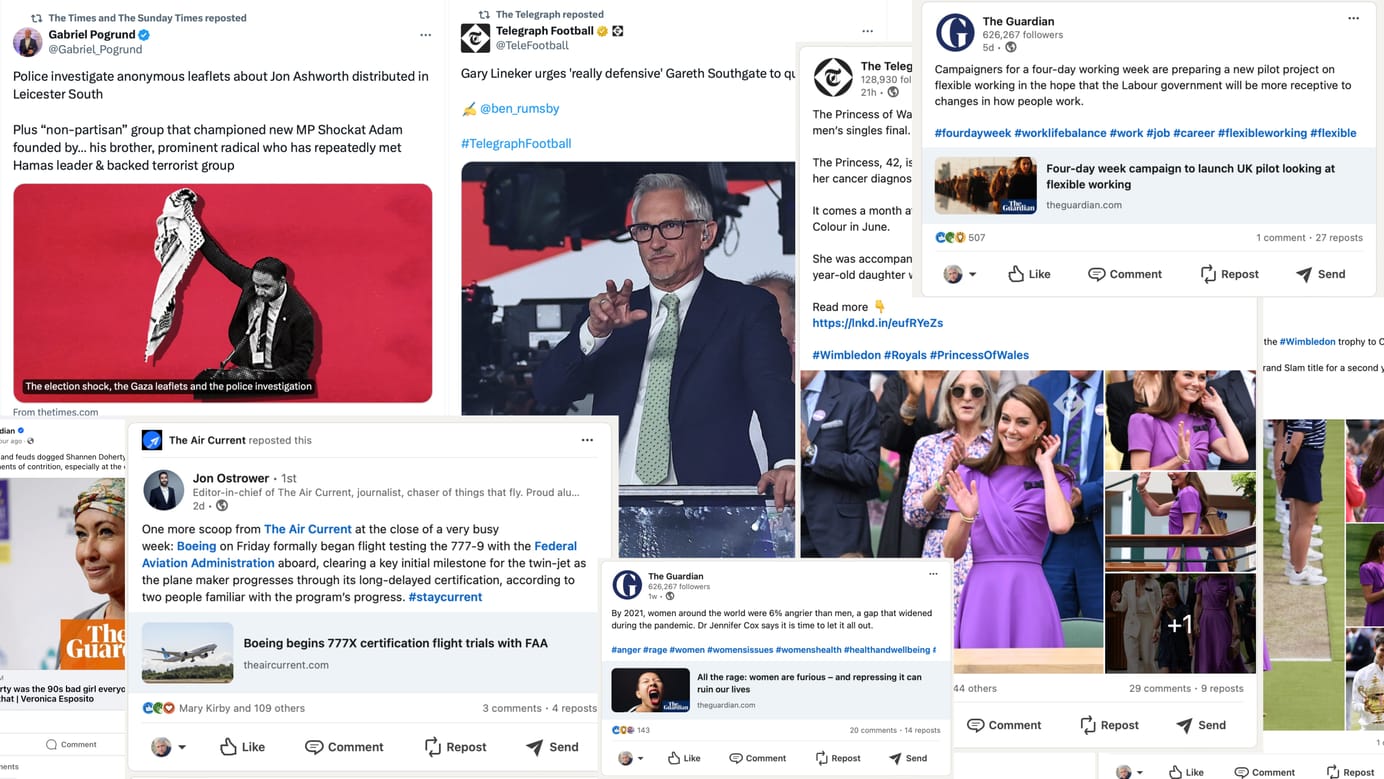
TikTok: should news organisations be on the platform now?
TikTok is beloved of Gen Z — but a lot less popular amongst Western governments. With a US ban looming, here’s how to rethink your strategy.
Over the last month, we’ve become familiar with government bodies banning TikTok from staff phones. The security risk, as they see it, is too severe. But there have been two serious escalations in the debate.
The first is the US getting serious again about the possibility of banning the app entirely, unless it transitions to non-Chinese ownership. And the second is the BBC advising that staff remove it from corporate phones. It’s time for the industry to stop treating TikTok as just another social media platforms, and think more deeply about the inherent risks of using a platform that’s under the control of an often antagonistic foreign power.
Yes, just as the news industry finally gets its head around TikTok — we’ve been teaching it at City for over half a decade now — it might be too late. Social platforms sometimes die, as those who used Vine will recall. But this is the first major time we in the west have experienced a political clampdown on a platform.
The trouble with TikTok is Bytedance
The problems driving these interventions are fairly clear:
- TikTok’s parent company ByteDance is Chinese, and there are laws about access to data by the Chinese government from such companies.
- China has shown a willingness to use “soft power” — culture power — to achieve its geopolitical ends
- TikTok itself has been caught using data for unethical purposes
One could easily argue that TikTok is harvesting little more data than Meta and its ilk have done over the years. That’s not the key issue, though. It’s who has access to that data — and what they could do with it. Russia’s invasion of Ukraine has made the world a little more politically edgy, quite rightly. The combination of leaving huge amounts of personal data in the hands of the Chinese, while granting them the power to algorithmically shape what our young people see and believe, is clearly a risk for the Western democracies.
The pressure to ban it is not going to lessen any time soon. And, if you find yourself sceptical that a major platform would be banned, just jump on a plane to China, and try to use Twitter or Facebook while you’re over there…
Should we still be using TikTok?
And so, we find ourselves in the situation where one of the most widely used platforms among the younger generations could well be banned in some countries, and seriously restricted in others. Does this means we should abandon TikTok?
Well, this presents something of a dilemma to the BBC. If you consider TikTok to be enough of a threat that staff should remove it from their phones, should you be encouraging your viewers to use it by producing content from the platform? Currently, they have no plans to quit publishing on it.
There’s a marked difference in the risk level of having, say, senior BBC news journalists tracked rather than someone working on CBeebies. And equally, the Chinese government will be deeply uninterested in many of our profiles, unless we are of geopolitical significance as journalists. So, one could, quite ethically, continue to produce for the platform while being wary of the app itself being on key staff’s phones. This is the approach being taken by some politicians: they don’t have it on their personal devices, but their comms team use it to reach the public.
(It’s also emblematic of the BBC’s internal struggles with TikTok, most memorably when a staffer gave an interview saying they didn’t think it was good for news, followed closely by an announcement about a new team…)
However, anybody who is devoting resources to TikTok right now would be wise to give some thought about the possibility of a post-TikTok era in the west.
A mindful TikTok strategy
I’d be cautious of building your reputation or brand solely on TikTok, unless the platform accedes to the US’s demands and completely detaches itself from China. If your youth engagement strategy begins and ends with TikTok, you’re taking one hell of a risk right now because that strategy could disappear almost overnight for tranches of the English-speaking world.
I’d also take a long, hard look at what you’re actually doing with your TikTok strategy. Are you merely helping reinforce TikTok as the place to be, or do you have some plan for taking relationships forged on TikTok and moving them towards your core, owned products? In short, are you building your brand, or are you building TikTok’s?
The original sin of social media use is building a presence there solely for the sake of having a presence there. If you don’t have a strategy for doing something that helps grow your publication based on that presence, then you don’t have a strategy at all. You’re just playing.
Everyone starts off with the basics: “journalists should be on platform X because that’s where young people are”. Sure. If all that matters to you is getting news in front of young people, then that’s what you should do. But if you need to make money, and your staff have limited time, you need to understand how that presence will, eventually, contribute to the bottom line. I can’t quite believe we still have people getting up and trotting out the “go where the young people are” line with no follow-up at journalism conference, but we do. Still, it’s a good excuse for an extra coffee break.
Going beyond social media brand building
Now, the solution many social teams have come up with is seeing it as long-term brand building: build a relationship with users now via the platform, in the hope that they’ll gravitate towards our main products as they age and their news needs grow. People have been doing this for over a decade. For example, look at The Economist and Snapchat. But that takes time, is almost impossible to prove, and is only really a justifiable investment for the largest newsrooms.
For the rest of us, we need to see more direct benefits. And that means you require some set of tactics for taking your audience off the platform, and into other, owned channels. Now, let’s be honest. TikTok is one of those platforms where that’s hard. There’s no useful linking — “link in bio!” — without even the edge that the link sticker gives you on Instagram.

So, you’re building ideas around calls to action, and indirect monitoring of referrals, by, for example, trying to match direct traffic surges with particular videos and their engagement levels. But it’s doable, and should be at least an element of your strategy. A TikTok video selling a key moment from an interview or an investigation is both a social object in its own right and a sales tool for the main story.
But then, you can do this with vertical video on other platforms. So, in your head at least, it’s time to stop “doing TikTok”. The critical thing isn’t the platform, it’s the content style. Start talking about short form vertical video production instead. That’s a format that can be expressed on multiple platforms: TikTok, Meta’s Reels and YouTube Shorts, currently.
Moving beyond TikTok
One of the greatest tricks that some platforms have managed to perform is getting us to talk about their brands rather than the content formal. We “do a TikTok” or “do YouTube”, instead of talking about producing short form vertical video, or long-form web video. (Or “write a Substack” rather than a newsletter 🤮)
The one exception to that was the original wave of social video:
- short
- usually square
- highly captioned
- audio independent.
It still exists, it still gets traction, and it works across multiple platforms, often without any need to re-edit.
But also think about how that format can be used to strengthen your website — or your app. The “TikTok” format, bar a few platform-specific features, is just time-constrained vertical social video. That basic technique can be learned, refined, and used elsewhere.
TikTok isn’t the only place to find Gen Z
In fact, the most recent Reuters Institute Digital News report makes it abundantly clear that, in most of the countries they looked at, Instagram may still be a more effective route to reaching the Gen Z demographic as TikTok. The vertical video form is becoming pervasive, and is as useful for the ‘gram and YouTube Shorts as it is for TikTok. These are transferable skills. And because the TikTok algorithm’s more about viral content than individual following relationships, it less likely you’ll lose a specific engaged community there if the platform eventually goes away.
Yes, you will have to tweak and edit some of those videos to make the most of the different conventions and formats of the various platforms. And an awareness of particular memes and formats that are popular will be important to getting reach. But the core video storytelling skills remain the same across the platforms.
If you think about what you’re doing as building a more comprehensive skills base in vertical social video, you’ll build a resilient audience function that’s capable of adapting if TikTok goes away. Never make your success dependent on a single platform.
Sign up for e-mail updates
Join the newsletter to receive the latest posts in your inbox.










